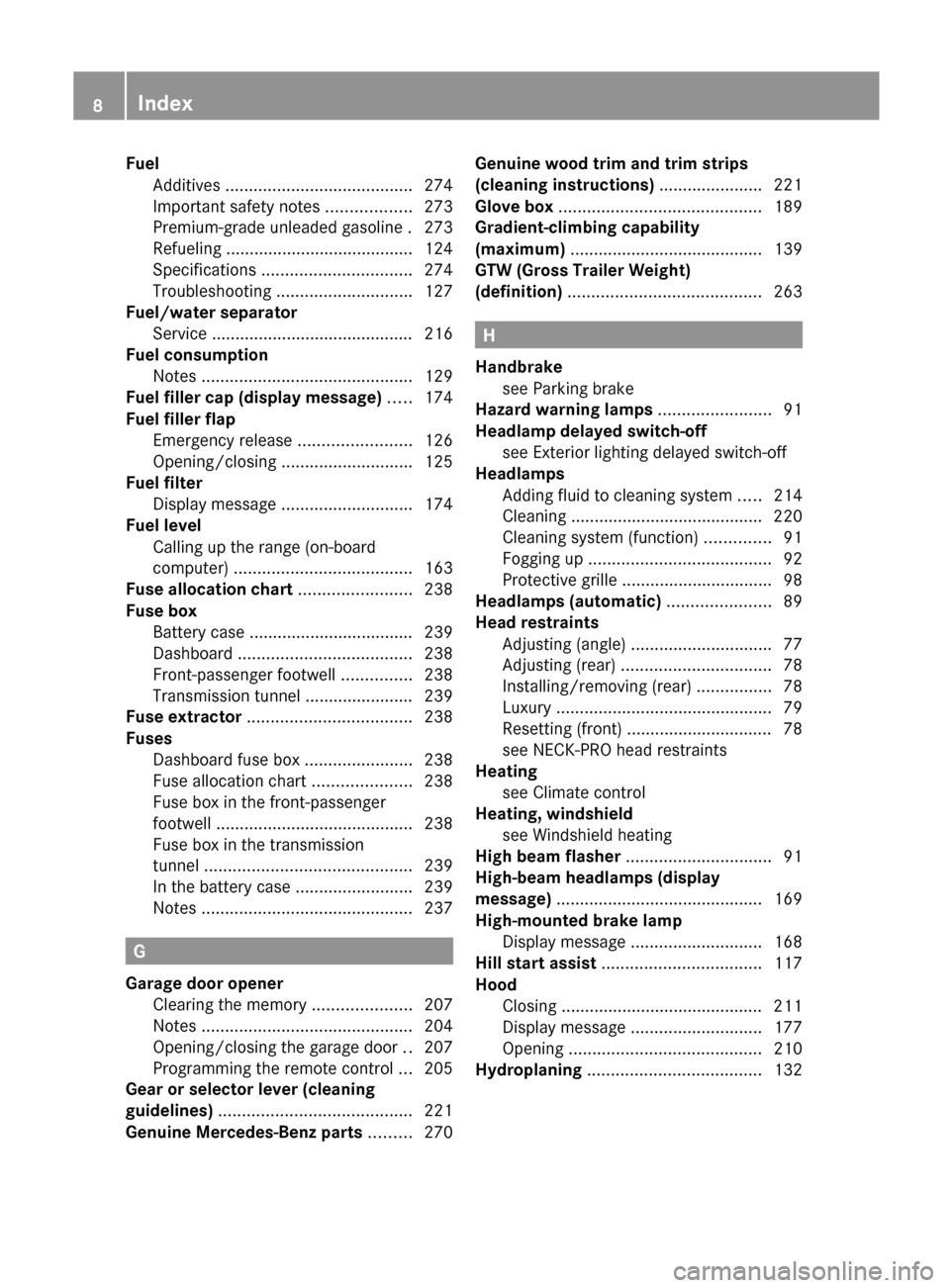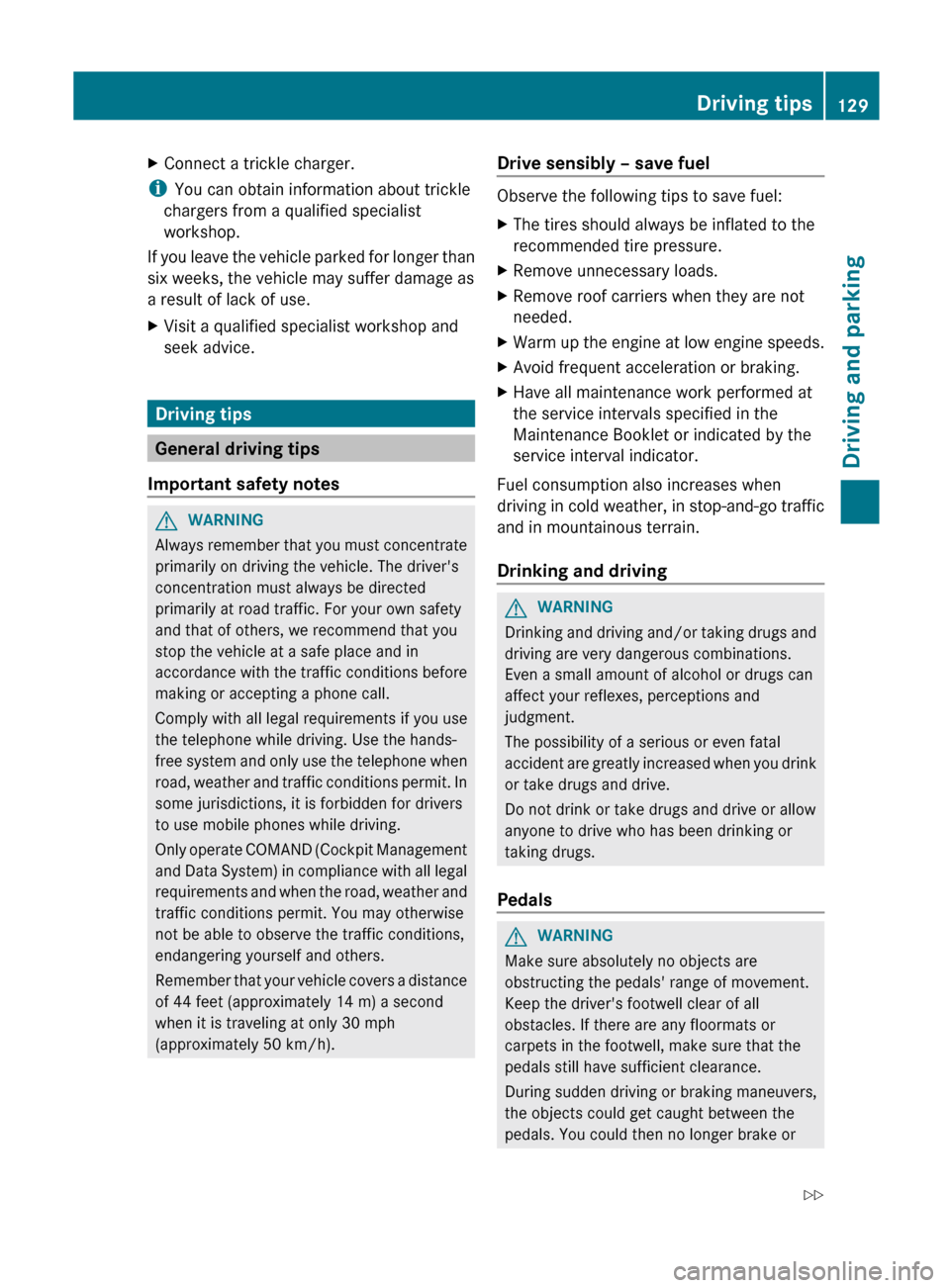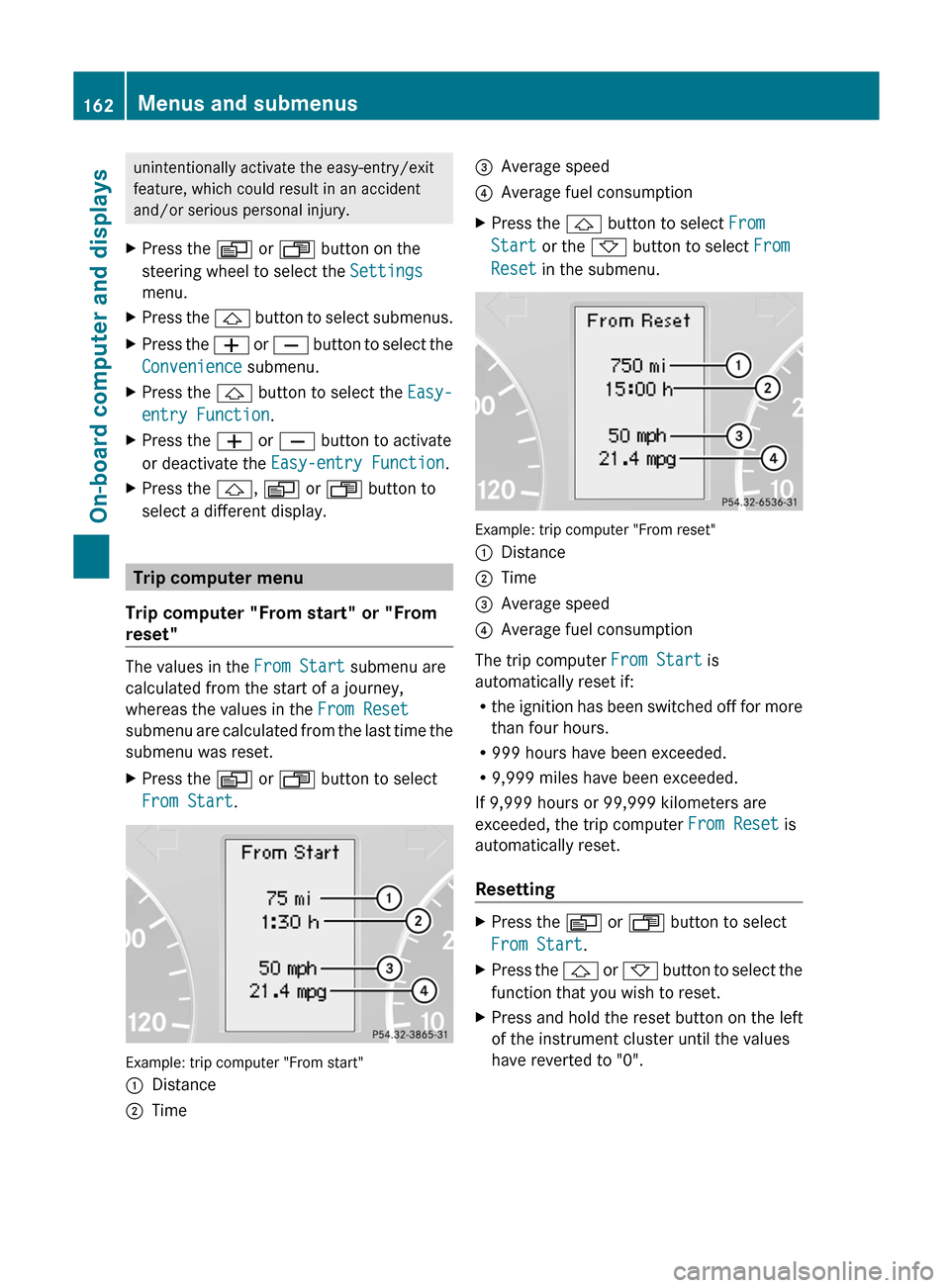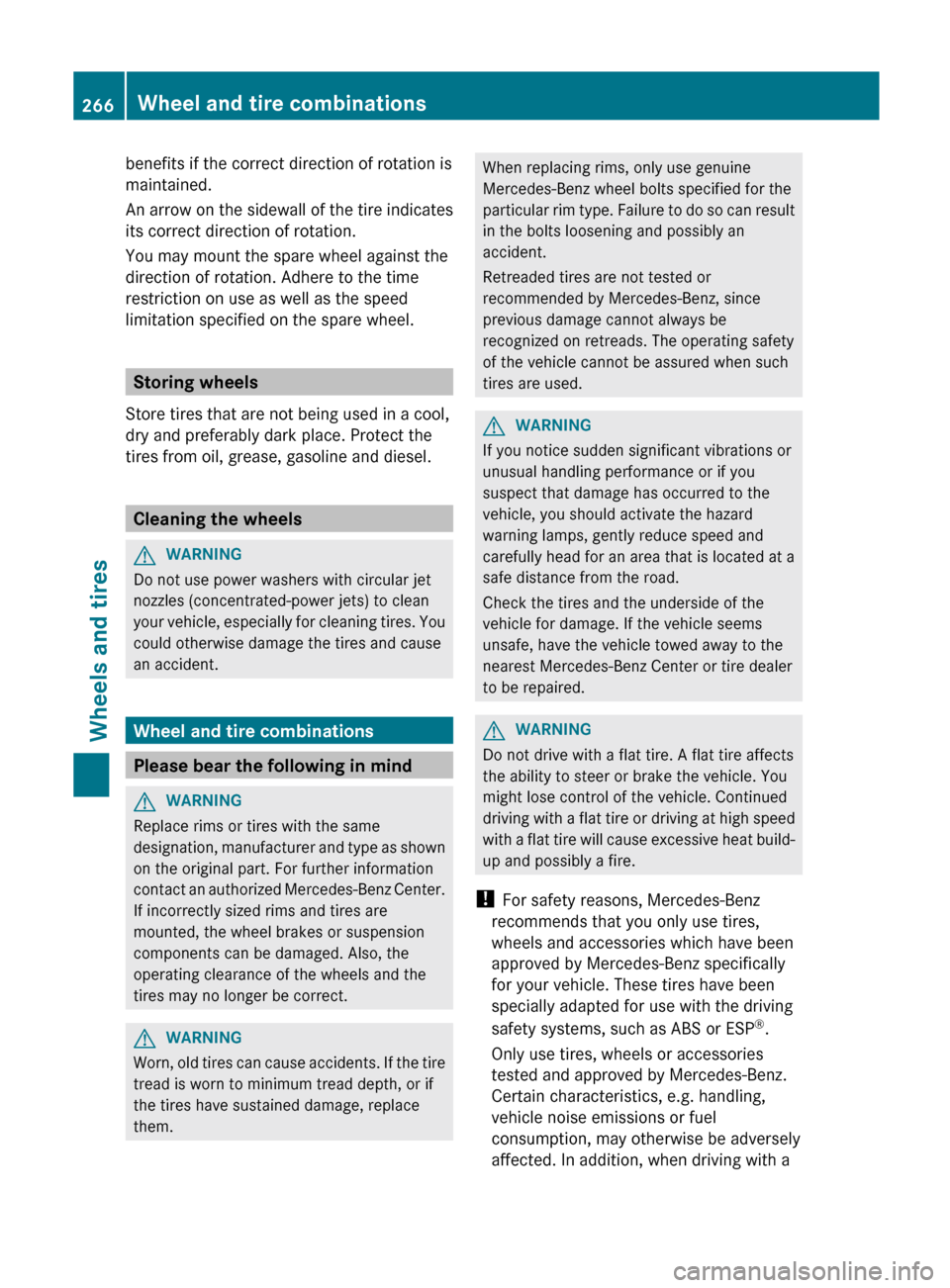fuel consumption MERCEDES-BENZ G-Class 2012 W463 Owner's Manual
[x] Cancel search | Manufacturer: MERCEDES-BENZ, Model Year: 2012, Model line: G-Class, Model: MERCEDES-BENZ G-Class 2012 W463Pages: 284, PDF Size: 9.4 MB
Page 10 of 284

Fuel
Additives ........................................ 274
Important safety notes
..................273
Premium-grade unleaded gasoline . 273
Refueling ........................................ 124
Specifications ................................ 274
Troubleshooting ............................. 127
Fuel/water separator
Service ........................................... 216
Fuel consumption
Notes ............................................. 129
Fuel filler cap (display message) .....174
Fuel filler flap Emergency release ........................ 126
Opening/closing ............................ 125
Fuel filter
Display message ............................ 174
Fuel level
Calling up the range (on-board
computer) ...................................... 163
Fuse allocation chart ........................238
Fuse box Battery case ................................... 239
Dashboard ..................................... 238
Front-passenger footwell ...............238
Transmission tunnel ....................... 239
Fuse extractor ................................... 238
Fuses Dashboard fuse box ....................... 238
Fuse allocation chart ..................... 238
Fuse box in the front-passenger
footwell .......................................... 238
Fuse box in the transmission
tunnel ............................................ 239
In the battery case ......................... 239
Notes ............................................. 237G
Garage door opener Clearing the memory
.....................207
Notes ............................................. 204
Opening/closing the garage door ..207
Programming the remote control ... 205
Gear or selector lever (cleaning
guidelines) ......................................... 221
Genuine Mercedes-Benz parts ......... 270Genuine wood trim and trim strips
(cleaning instructions)
......................221
Glove box ........................................... 189
Gradient-climbing capability
(maximum) ......................................... 139
GTW (Gross Trailer Weight)
(definition) ......................................... 263 H
Handbrake see Parking brake
Hazard warning lamps ........................91
Headlamp delayed switch-off see Exterior lighting delayed switch-off
Headlamps
Adding fluid to cleaning system .....214
Cleaning ......................................... 220
Cleaning system (function) .............. 91
Fogging up ....................................... 92
Protective grille ................................ 98
Headlamps (automatic) ......................89
Head restraints Adjusting (angle) .............................. 77
Adjusting (rear) ................................ 78
Installing/removing (rear) ................ 78
Luxury .............................................. 79
Resetting (front) ............................... 78
see NECK-PRO head restraints
Heating
see Climate control
Heating, windshield
see Windshield heating
High beam flasher ............................... 91
High-beam headlamps (display
message) ............................................ 169
High-mounted brake lamp Display message ............................ 168
Hill start assist .................................. 117
Hood Closing ........................................... 211
Display message ............................ 177
Opening ......................................... 210
Hydroplaning ..................................... 1328
Index
Page 131 of 284

X
Connect a trickle charger.
i You can obtain information about trickle
chargers from a qualified specialist
workshop.
If you
leave the vehicle parked for longer than
six weeks, the vehicle may suffer damage as
a result of lack of use.
X Visit a qualified specialist workshop and
seek advice. Driving tips
General driving tips
Important safety notes G
WARNING
Always remember that you must concentrate
primarily on driving the vehicle. The driver's
concentration must always be directed
primarily at road traffic. For your own safety
and that of others, we recommend that you
stop the vehicle at a safe place and in
accordance with
the traffic conditions before
making or accepting a phone call.
Comply with all legal requirements if you use
the telephone while driving. Use the hands-
free system and only use the telephone when
road, weather and traffic conditions permit. In
some jurisdictions, it is forbidden for drivers
to use mobile phones while driving.
Only operate COMAND (Cockpit Management
and Data System) in compliance with all legal
requirements and when the road, weather and
traffic conditions permit. You may otherwise
not be able to observe the traffic conditions,
endangering yourself and others.
Remember that your vehicle covers a distance
of 44 feet (approximately 14 m) a second
when it is traveling at only 30 mph
(approximately 50 km/h). Drive sensibly – save fuel Observe the following tips to save fuel:
X
The tires should always be inflated to the
recommended tire pressure.
X Remove unnecessary loads.
X Remove roof carriers when they are not
needed.
X Warm up the engine at low engine speeds.
X Avoid frequent acceleration or braking.
X Have all maintenance work performed at
the service intervals specified in the
Maintenance Booklet or indicated by the
service interval indicator.
Fuel consumption also increases when
driving in
cold weather, in stop-and-go traffic
and in mountainous terrain.
Drinking and driving G
WARNING
Drinking and driving and/or taking drugs and
driving are very dangerous combinations.
Even a small amount of alcohol or drugs can
affect your reflexes, perceptions and
judgment.
The possibility of a serious or even fatal
accident are
greatly increased when you drink
or take drugs and drive.
Do not drink or take drugs and drive or allow
anyone to drive who has been drinking or
taking drugs.
Pedals G
WARNING
Make sure absolutely no objects are
obstructing the pedals' range of movement.
Keep the driver's footwell clear of all
obstacles. If there are any floormats or
carpets in the footwell, make sure that the
pedals still have sufficient clearance.
During sudden driving or braking maneuvers,
the objects could get caught between the
pedals. You could then no longer brake or Driving tips
129
Driving and parking
Z
Page 164 of 284

unintentionally activate the easy-entry/exit
feature, which could result in an accident
and/or serious personal injury.
X Press the V or U button on the
steering wheel to select the Settings
menu.
X Press the & button
to select submenus.
X Press the W or X
button to select the
Convenience submenu.
X Press the & button to select the Easy-
entry Function.
X Press the W or X button to activate
or deactivate the Easy-entry Function.
X Press the &, V or U button to
select a different display. Trip computer menu
Trip computer "From start" or "From
reset" The values in the
From Start
submenu are
calculated from the start of a journey,
whereas the values in the From Reset
submenu are
calculated from the last time the
submenu was reset.
X Press the V or U button to select
From Start. Example: trip computer "From start"
:
Distance
; Time =
Average speed
? Average fuel consumption
X Press the
& button to select
From
Start or the * button to select From
Reset in the submenu. Example: trip computer "From reset"
:
Distance
; Time
= Average speed
? Average fuel consumption
The trip computer From Start is
automatically reset if:
R the ignition
has been switched off for more
than four hours.
R 999 hours have been exceeded.
R 9,999 miles have been exceeded.
If 9,999 hours or 99,999 kilometers are
exceeded, the trip computer From Reset is
automatically reset.
Resetting X
Press the
V or U button to select
From Start.
X Press the &
or *
button to select the
function that you wish to reset.
X Press and hold the reset button on the left
of the instrument cluster until the values
have reverted to "0".162
Menus and submenus
On-board computer and displays
Page 249 of 284

Make sure that the tire pressure for normal
speeds is adopted again.
Additional specifications of tire pressure
values
for
loads can also be found on the tire
pressure table on the inside of the fuel filler
flap.
Observe the following for the tire pressure on
the spare wheel:
R the tire and loading information table on
the B-pillar on the driver's side.
R the tire pressure sticker on the inside of the
fuel filler flap.
i Specifications shown in the examples of
tire pressure tables are for illustration
purposes only. Tire pressure specifications
are vehicle-specific and may deviate from
the data shown here. Tire pressure
specifications applicable to your vehicle
are located in your vehicle's tire pressure
table.
Unless stated otherwise, the tire pressures
specified on the fuel filler flap apply for all
tires approved for this vehicle. Tire pressure table for all tires permitted for this
vehicle by the factory (example)
If
a
tire size precedes a tire pressure, the tire
pressure information following is only valid
for that tire size. The load conditions "partially
laden" and "fully laden" are defined in the
table for different numbers of passengers and
amounts of luggage. The actual number of
seats may differ. Tire pressure table with tire dimensions (example)
Some tire pressure tables only show the rim
diameter instead of the complete tire size,
e.g. R16. The rim diameter is part of the tire
size and can be found on the tire sidewall
(Y page 259).
Underinflated or overinflated tires
Underinflation G
WARNING
Follow recommended tire inflation pressures.
Do not underinflate tires. Underinflated tires
wear excessively and/or unevenly, adversely
affect handling and fuel economy, and are
more likely to fail from being overheated.
Underinflated tires may:
R wear quickly and unevenly
R have an
adverse effect on fuel consumption
R overheat leading to tire defects
R have an adverse effect on handling
characteristics Tire pressure
247
Wheels and tires Z
Page 268 of 284

benefits if the correct direction of rotation is
maintained.
An
arrow
on the sidewall of the tire indicates
its correct direction of rotation.
You may mount the spare wheel against the
direction of rotation. Adhere to the time
restriction on use as well as the speed
limitation specified on the spare wheel. Storing wheels
Store tires that are not being used in a cool,
dry and preferably dark place. Protect the
tires from oil, grease, gasoline and diesel. Cleaning the wheels
G
WARNING
Do not use power washers with circular jet
nozzles (concentrated-power jets) to clean
your vehicle,
especially for cleaning tires. You
could otherwise damage the tires and cause
an accident. Wheel and tire combinations
Please bear the following in mind
G
WARNING
Replace rims or tires with the same
designation, manufacturer
and type as shown
on the original part. For further information
contact an authorized Mercedes-Benz Center.
If incorrectly sized rims and tires are
mounted, the wheel brakes or suspension
components can be damaged. Also, the
operating clearance of the wheels and the
tires may no longer be correct. G
WARNING
Worn, old tires can cause accidents. If the tire
tread is worn to minimum tread depth, or if
the tires have sustained damage, replace
them. When replacing rims, only use genuine
Mercedes-Benz wheel bolts specified for the
particular
rim
type. Failure to do so can result
in the bolts loosening and possibly an
accident.
Retreaded tires are not tested or
recommended by Mercedes-Benz, since
previous damage cannot always be
recognized on retreads. The operating safety
of the vehicle cannot be assured when such
tires are used. G
WARNING
If you notice sudden significant vibrations or
unusual handling performance or if you
suspect that damage has occurred to the
vehicle, you should activate the hazard
warning lamps, gently reduce speed and
carefully head for an area that is located at a
safe distance from the road.
Check the tires and the underside of the
vehicle for damage. If the vehicle seems
unsafe, have the vehicle towed away to the
nearest Mercedes-Benz Center or tire dealer
to be repaired. G
WARNING
Do not drive with a flat tire. A flat tire affects
the ability to steer or brake the vehicle. You
might lose control of the vehicle. Continued
driving with
a flat tire or driving at high speed
with a flat tire will cause excessive heat build-
up and possibly a fire.
! For safety reasons, Mercedes-Benz
recommends that you only use tires,
wheels and accessories which have been
approved by Mercedes-Benz specifically
for your vehicle. These tires have been
specially adapted for use with the driving
safety systems, such as ABS or ESP ®
.
Only use tires, wheels or accessories
tested and approved by Mercedes-Benz.
Certain characteristics, e.g. handling,
vehicle noise emissions or fuel
consumption, may otherwise be adversely
affected. In addition, when driving with a 266
Wheel and tire combinationsWheels and tires